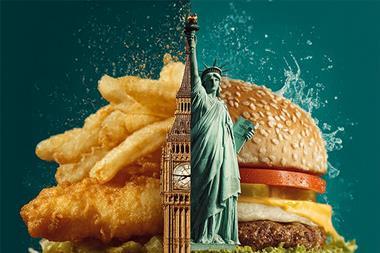There has been much talk of the changing face of Britain’s high streets and the declining fortunes of the retail brands that have dominated them. MCA’s director of insight Steve Gotham investigates what lessons can be learnt and parallels drawn for the eating and drinking out sector.
Here’s a question that you might not have been asked before: If there are just two hairdressers in a small town and one has a very tidy looking salon that is clean and where the hairdresser is well presented with well-groomed hair; while the other hairdresser has unruly looking hair and has a scruffy looking and untidy shop, which should you choose? The answer of course, is … you are best going to the scruffy salon as the hairdresser here cuts hair better than the other person. So yes, nothing like a spot of lateral thinking to try to hook the reader in! With this in mind, what follows are some observations and opportunities from answering the question about which foodservice channels best compare with specific retail segments on the high street.
Womenswear: fashion-led
The core retail stalwart segment of any high street has to be womenswear and for the likes of H&M, Next, Top Shop and Zara, two key critical factors are occasion-wear and fashionability. Arguably, the foodservice channel where these influences are most encapsulated is casual dining. It almost goes without saying that having an offer that is well suited to different consumer missions and that works across different day-parts is crucially important. This is also true of swiftly responding to emerging trends and fashions, albeit within the context of hopefully, an enduringly popular, house cuisine style.
When pushed to nominate two key insights from the world of womenswear that could be leveraged better within casual dining, there is firstly a greater understanding of the drivers of change in taste and dietary fashions within specific target audiences so that emerging market opportunities can be capitalised upon. Secondly, and related, is being more aware of trends that enable higher prices to be charged and which can drive sales values and boost profitability. Good examples from fashion is when boots are more in vogue than shoes, or when there is a new coat style hot trend. Looking across casual dining, however, the popularity of steaks and lobster does not quite seem to be as strong these days and this does beg the question about what will come through to replace them? Something will for sure, but in the interim, I am not sure rising demand for plant-based options will help drive growth in comparable store sales or cash profit.
Grocery retailing: scale-led
The biggest retail channel comprises the grocery multiples. The biggest retail beast, Tesco, Sainsbury’s, Asda and Morrisons, are not without several key challenges; most notably reduced consumer enthusiasm for their core product, the weekly supermarket trip. Factor in multiple different formats and nigh on ubiquitous competition, then there can only be one comparative foodservice channel – pubs.
So, what lessons exists for the leading pub companies from the supermarket sector? Looking back over grocery market history the main growth strategy used has been the remorseless pursuit of greater scale. Buying power is fundamental in a world where the essential competition lies with who has the most efficient supply chain. Various mergers and acquisitions have led to the existing big four – and this might even become a bigger three before the year’s out. Arguably, the pub industry has not always capitalised on M&A activity quite as well as it might, but the underlying logic remains compelling. The other key take-out from the grocery trade is the importance of recognising a customer’s life-long value and focusing on ways to strengthen loyalty through a greater focus on customer relationship. Leading grocers continue to invest heavily in various formal reward schemes that yield rich insights into consumer behaviour. Developing and leveraging consumer contact databases are standard initiatives among several leading pub companies these days, but maybe the extraction of actionable consumer insights is not so advanced. However, with the advent of social media there are also cost effective means for smaller scale and budget-constrained enterprises to maintain dialogues with guests that enhance and add value to customer relationships.
CTNs/C-stores: repeat-led
Confectionery, Tobacco & News has been the precursor to the more contemporary iteration, the convenience store. As can be expected, average transaction values are low, with substantial habitual purchasing. Moreover, spending is predominantly from a highly localised clientele. The most analogous foodservice channel here is contract catering.
To be fair to the leading caterers, however, there are more limited lessons that can be extracted from this retail activity. As already highlighted, the majority of CTNs have transitioned into C-stores, by adding more products and services that add more reasons to visit. They have also added more perishable offerings and food to go for immediate consumption. Similarly, contract caterers have looked to be more responsive to ways of capturing a greater share of customer on-site spend and have added greater convenience and transactional technology to how consumer orders are processed more quickly. However, arguably the best tactic the most successful c-stores exploit is the power of greater interpersonal relationships. Knowing your regular customers individually and helping to put a smile on their faces might just be the single most compelling form of customer relationship development.
And finally, something completely different …
At the pinnacle of the eating out of home pyramid is fine dining, and I have been racking my retail thinking cap for a suitable analogy. Maybe a comparison case can be made for the top-end department stores of Harrods, Harvey Nichols and their ilk. While all very aspirational and premium, it is difficult to escape the point that in essence, the department store is/was all about one-stop convenience, and how now, this is fast becoming the domain of online retailing.
The critically important elements within any fine dining operation are for all the back of house and front of house activities to come together at just the right time and combine to create a memorable and holistic experience that really is greater than the sum of the inherent parts. Actually, the best place that aims to deliver this on a daily basis is not in retail but in theatreland. The best shows genuinely communicate passion and offer a truly multi-sensory experience. Hopefully, I am not the only person who believes these virtues should not just be the preserve of fine dining …











































